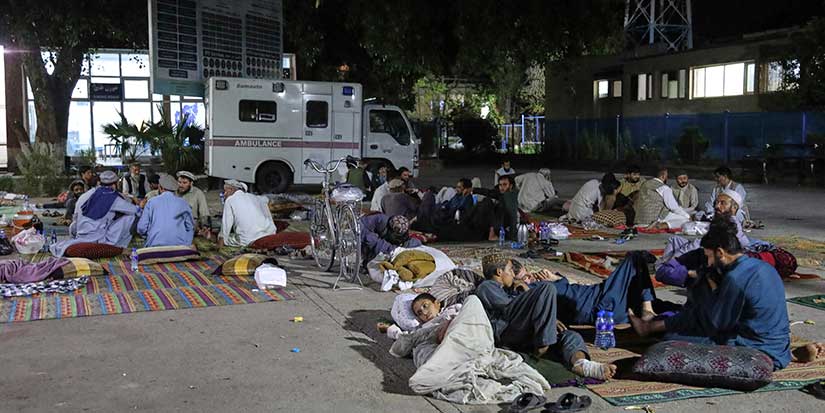National News
ER visits for pneumonia doubled last fall, CIHI data shows
Published 10:41 PDT, Thu September 11, 2025
—
The number of emergency department visits for pneumonia more than doubled last fall over the previous year, the Canadian Institute for Health Information says.
The new data released Thursday said young people between five and 19 years old were the hardest hit.
"This is actually the largest increase in pneumonia-related emergency department visits that we've seen post-COVID," Tanya Khan, CIHI's manager of hospital data advancement and engagement, said in an interview.
Pneumonia didn't make the top 10 list of reasons people visited the ER in 2023-24 but it shot up to No. 3 in 2024-25, after abdominal and pelvic pain and throat and chest pain, Khan said.
The number of visits more than doubled in the months of September, October and November, jumping by as much as 132 per cent in October 2024, when there were 24,242 visits compared to 10,432 recorded the same month in 2023.
Dr. Anna Banerji, a pediatric infectious diseases specialist in Toronto, said the CIHI numbers likely reflect an influx of patients with atypical pneumonia — known as walking pneumonia — during last year's respiratory illness season.
Walking pneumonia usually causes milder symptoms than other types of pneumonia, including cough, fever and fatigue.
"A lot of people with this kind of pneumonia can get better on their own," Banerji said.
But in some cases, walking pneumonia can be severe and lead to neurological symptoms and rashes, she said.
Parents should seek medical attention for their kids if their cough, fever or fatigue persist, doctors say.
Dr. Steve Lin, interim director of the emergency department at St. Michael's Hospital in Toronto, said his hospital "definitely" saw more pneumonia cases last fall and most were likely walking pneumonia.
"The people that we saw in our department were those who had really bad coughs that lingered well beyond what they expected," he noted.
He said walking pneumonia comes in cycles and suspects the especially high jump in illnesses was due to an "immunity debt" after COVID-19 precautions further limited exposure to the bacteria that causes the illness.
"We didn't have that sharp rise during the pandemic because people stayed away, they were masking and they had a lot of precautions," Lin said.
Lin expected to see less walking pneumonia this fall and winter. He said his emergency department is preparing for a rise in viral infections, including flu, COVID-19 and RSV.
Walking pneumonia is usually caused by a bacteria called mycoplasma pneumoniae. If treatment is required, an antibiotic from the macrolides class of medications — which includes azithromycin, clarithromycin and erythromycin — is needed instead of the amoxicillin commonly used against pneumonia.
Mycoplasma bacteria "doesn't have the cell wall that antibiotics like amoxicillin attack, so that's why amoxicillin and the penicillins don't work for this kind of pneumonia," Banerji said.
Banerji said it's not known if walking pneumonia will make a significant reappearance this fall, but noted various viruses and bacterial infections increased after COVID-19 precautions — such as masking — stopped.
That includes an especially bad season for respiratory syncytial virus that hospitalized many children a couple of years ago, she said.
Shirley Quach, director of person-centred care and programs for the Lung Health Foundation, said epidemiological data shows walking pneumonia cases follow a cycle where the number of infections peaks every three to seven years.
“While last year could be the apex of the cycle, we should still be watching out for walking pneumonia this fall ... irrespective of the cycle," Quach said in an email.
Quach said this is the time of year when respiratory illnesses start appearing in greater numbers as people spend more time indoors and children go back to school.
"That kind of proximity makes it easier for bacteria and viruses to easily spread through respiratory droplets, such as coughing, and sneezing. People can be infected without symptoms and pass on the infection to people they interact with closely," she said.
Lin urged people to help stop the spread of respiratory illnesses by keeping kids home from school if they are sick, washing hands frequently and wearing a mask if feeling unwell
"I think what we've learned from COVID is that masking does prevent spread quite well."
The CIHI data recorded 7,542 emergency department visits for pneumonia across Canada in September 2023 and 16,489 in September 2024 — a 119 per cent increase.
In October 2023 there were 10,432 visits, rising to 24,242 visits in October 2024 — a 132 per cent increase.
In November 2023 there were 12,774 pneumonia visits and in November 2024 there were 28,308 — a 122 per cent rise.
CIHI estimates it has data from at least 89 per cent of emergency departments in Canada.
———
– Nicole Ireland, The Canadian Press
With files from Hannah Alberga in Toronto.
Canadian Press health coverage receives support through a partnership with the Canadian Medical Association. CP is solely responsible for this content.































